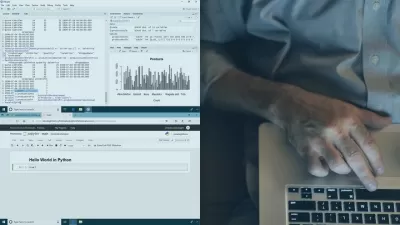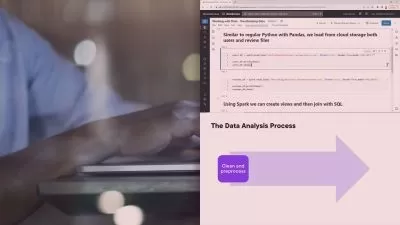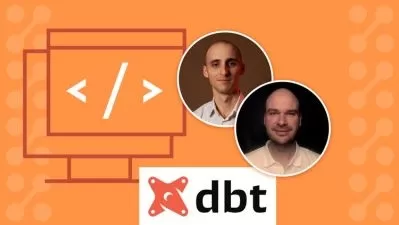Learn Mulesoft: Intro to Common Data Integration Patterns
Nelson Dias
3:38:09
Description
Master the basic 10 integration use cases and 5 integration patterns to create APIs and integration services with Mule!
What You'll Learn?
- Learn the answer to the question: "what is Mulesoft?"
- Learn the concepts behind API-led connectivity: a new integration architecture approach that will make SOA and Microservices obsolete!
- Introducing MuleSoft and the Application Network vision
- Explain MuleSoft’s proposal for closing the increasing IT delivery gap
- Classify and describe the characteristics of common enterprise systems
- Classify and describe the tradeoffs of legacy and modern integration approaches
- Given a complex business problem, identify the fundamental integration use cases that can deliver an end-to-end business solution
- Describe the purpose and function of the different classes of integration technologies
- Identify the types of integration technologies that are most suitable to realize different integration use cases and business scenarios
- Deconstruct an integration solution into its integration system constituents
- Describe the differences between the request-reply, one-way, multicast, batch, and stream interaction patterns
- Explain the differences between the aggregation, orchestration, and choreography composition patterns
- Describe the differences and tradeoffs between monolithic and microservices application architectures
- Create high-level integration architectures using API-led connectivity
- Create high-level integration architectures using web APIs and HTTP
- Create high-level integration architectures using event-driven APIs and message brokers
- Design Mule applications and integration solutions using common messaging patterns and technologies
Who is this for?
What You Need to Know?
More details
DescriptionThis course was created with one goal only:Â
to teach you more and more about Mulesoft, so at the end of this course you should be familiar with the most common integration use cases and integation patterns to create APIs and integration services, with practical examples, so you can use in your real life projects out there.
In resume, this course will level up your Mulesoft game and help you out progress from a Mule Developer (MCD) to a Mule Architect (MCIA) by learning the 10 basic integration use cases and 5 integration patterns that are used to create APIs in the middleware world!
So, don't worry if you have no prior knowledge!
Start Learning Now. Hit the Enroll Button!
The main principle behind this course is to introduce all contents in a very detailed but easy way, so it can results in a few benefits for all students enrolled:
Reduces your learning curve at maximum by going straight to the point;
Clear Introduction and hands-on experience to the most popular tools used in a real life Mulesoft project:Â anypoint studio, message brokers, postman;
Gives you the skills needed to get prepared for the next step in the middleware world and become an Enterprise Architect, an IntegrationArchitect or a Solution Architect;
Gives you the knowledge and foundations to become yourself a Mulesoft Certified Integration Architect (MCIA);
Gives you the knowledge needed to apply for a new opportunity in the software sector as a Mulesoft Integration Architect;
In resume, it gives you all the tools to get a high-paying job.
But how we will accomplish that?
Shortly, through a hands-on experience, we will cover in detail all the most important topics which are required to design and implement integration solutions with Mulesoft.
Thus, at the end of the course you will:
test your knowledge with dozens of quizzes
hands-on practice with practical assignments
So, what are you waiting for?
Learn more about data integration patterns with Mulesoft. Hit the Enroll Button!
Who this course is for:
- Students curious to learn about a top trending technology for the future.
- Software professionals who are looking for a career change option into Mulesoft.
- Non-software professionals who are looking for to start a new career in the IT sector.
- All professionals who are looking for to work with one of to most in-demanding technology and get a better salary.
- Mulesoft Developers that want to become Mulesoft Certified Integration Architect (MCIA)
- Everyone aiming to to take the Mulesoft Certified Integration Architect (MCIA) exam
- Enterprise Architects new to Anypoint Platform, API-led connectivity, and the application network approach
This course was created with one goal only:Â
to teach you more and more about Mulesoft, so at the end of this course you should be familiar with the most common integration use cases and integation patterns to create APIs and integration services, with practical examples, so you can use in your real life projects out there.
In resume, this course will level up your Mulesoft game and help you out progress from a Mule Developer (MCD) to a Mule Architect (MCIA) by learning the 10 basic integration use cases and 5 integration patterns that are used to create APIs in the middleware world!
So, don't worry if you have no prior knowledge!
Start Learning Now. Hit the Enroll Button!
The main principle behind this course is to introduce all contents in a very detailed but easy way, so it can results in a few benefits for all students enrolled:
Reduces your learning curve at maximum by going straight to the point;
Clear Introduction and hands-on experience to the most popular tools used in a real life Mulesoft project:Â anypoint studio, message brokers, postman;
Gives you the skills needed to get prepared for the next step in the middleware world and become an Enterprise Architect, an IntegrationArchitect or a Solution Architect;
Gives you the knowledge and foundations to become yourself a Mulesoft Certified Integration Architect (MCIA);
Gives you the knowledge needed to apply for a new opportunity in the software sector as a Mulesoft Integration Architect;
In resume, it gives you all the tools to get a high-paying job.
But how we will accomplish that?
Shortly, through a hands-on experience, we will cover in detail all the most important topics which are required to design and implement integration solutions with Mulesoft.
Thus, at the end of the course you will:
test your knowledge with dozens of quizzes
hands-on practice with practical assignments
So, what are you waiting for?
Learn more about data integration patterns with Mulesoft. Hit the Enroll Button!
Who this course is for:
- Students curious to learn about a top trending technology for the future.
- Software professionals who are looking for a career change option into Mulesoft.
- Non-software professionals who are looking for to start a new career in the IT sector.
- All professionals who are looking for to work with one of to most in-demanding technology and get a better salary.
- Mulesoft Developers that want to become Mulesoft Certified Integration Architect (MCIA)
- Everyone aiming to to take the Mulesoft Certified Integration Architect (MCIA) exam
- Enterprise Architects new to Anypoint Platform, API-led connectivity, and the application network approach
User Reviews
Rating
Nelson Dias
Instructor's Courses
Udemy
View courses Udemy- language english
- Training sessions 39
- duration 3:38:09
- Release Date 2024/07/07

















